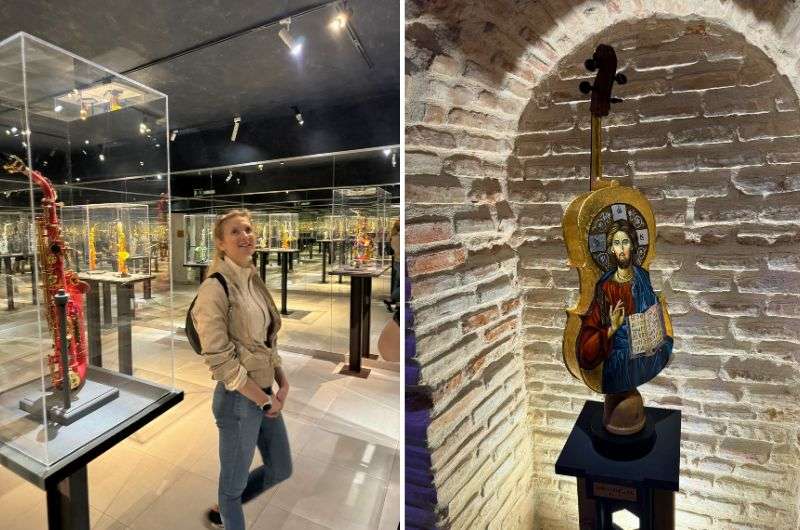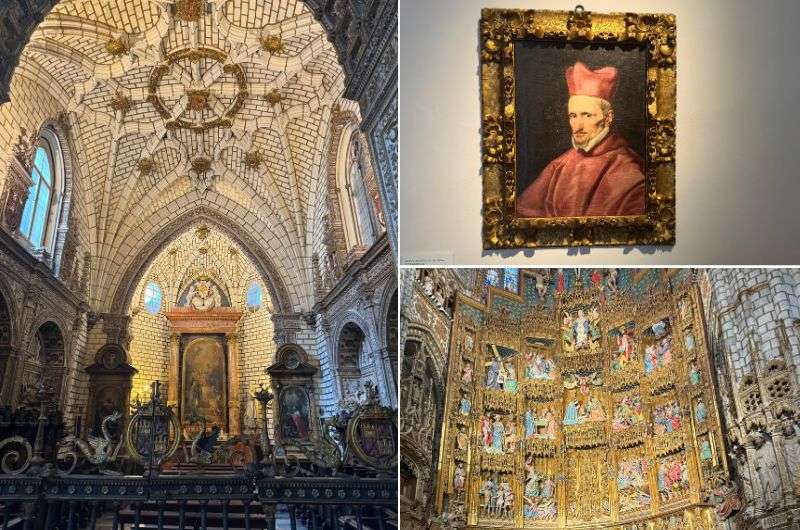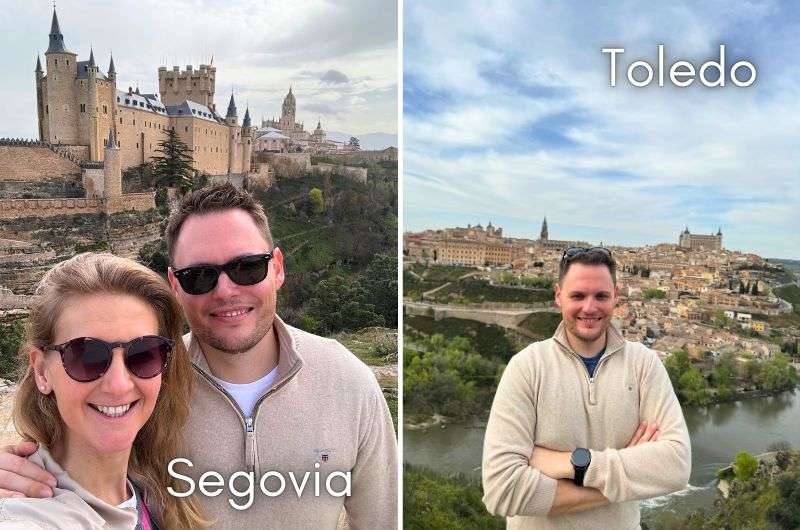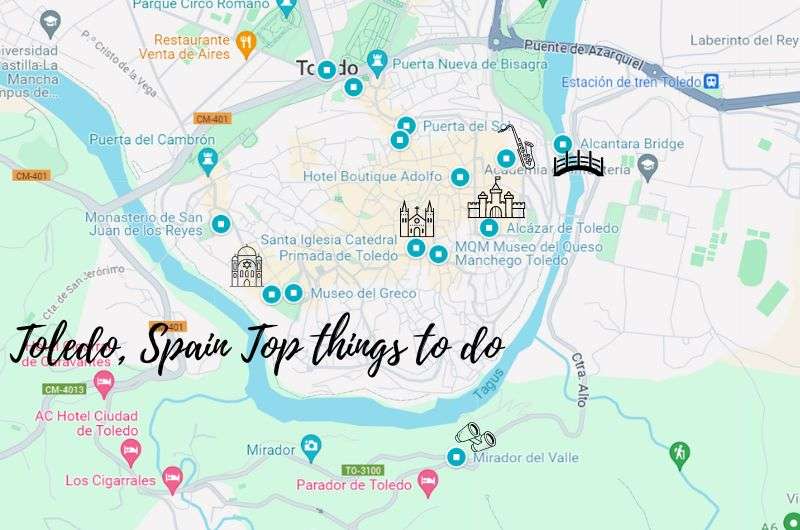What to Do in Toledo Spain: Top 10 Things to See in a Day


I had high expectations for Toledo based on all the stunning pictures and El Greco paintings depicting the city. And they weren’t lying! It has a rich history, breathtaking landscapes, fantastic restaurants, and, best of all, it’s incredibly compact for one day of city sightseeing.
You’re definitely going to visit the Alcázar of Toledo, the little mosque that’s actually a church, and the Cathedral (which, honestly, I found the weakest among the neighboring cathedrals). The funny thing is that I expected a lot more dedication to legendary author Miguel de Cervantes and his Don Quixote. If this were the US, everything from cafes to kindergartens would be named after him. But in Toledo—not that prominent.
Anyway, one day and you’re done with Toledo, but consider an overnight stay, because Toledo without the day trippers is heaven (get my Toledo 1-day itinerary if you’re ready to explore). Try out Hotel Boutique Adolfo close to the fortress—it’s remarkable. Alternatively, I would make Toledo my base for sightseeing in Castile-La Mancha and around Madrid.
>> Ready to go? Read my 1-day Toledo itinerary for detailed trip planning guide. <<

Your guides to Toledo
Quick list of my top 10 things to do in Toledo Spain:
The 10 best things to do in Toledo Spain in one day, in order of how I liked them, are:
- Museo Cromático
- Toledo Alcázar
- Walls and gates of Toledo, and the bridge of Alcántara
- Mirador del Valle
- Toledo Cathedral
- Museo Sefardí and Synagogue of El Tránsito
- El Greco Museum
- Monasterio de San Juan de los Reyes
- Mosque of Christ
- Museo del Queso Manchego (Yes, a cheese museum. Questionable, I admit.)
Toledo Spain orientation + map
Here’s a map showing the location of the 10 top things to do in Toledo Spain covered in this article. You can get the list on Google Maps and use it for your own trip
Be prepared: Toledo is much larger than the surrounding historic towns like Ávila and Segovia. But if you park by one of the city gates, you’ll be just fine getting around on foot. The escalators in Toledo (yes, they have those), Spain are located near the Puerta del Sol, providing convenient access to the old town. They help visitors navigate the steep incline of the city, making it easier to reach the historic center without breaking a sweat. You’ll probably use them more than once, and I can say I appreciated the lift.
The city of Toledo is perched on a hill and surrounded by ancient walls, with gates that lead you into a maze of narrow, winding streets. Toledo’s medieval streets are magical and reminiscent of Jerusalem. The whole city is beautiful, not just the monuments scattered around town.
Swords are for sale everywhere, thanks to the famous Toledo steel, and you can practically hear the echoes of knights clashing. The city’s diverse history is on full display, with Gothic, Mudéjar, and Renaissance styles blending seamlessly. You’ll stumble upon beautiful courtyards, charming squares, and unexpected views of the Tagus River.
1. Cromática Museum

The exhibits of the Cromática Museum are based on the artistic enhancement of musical instruments. Loved it!
- Price: EUR 8 including welcome drink. Tickets are valid all day, including during concerts.
- Opening hours: Daily except Tuesdays 11 am–8 pm
- Website: Cromática Museum
- Why I liked it: Cool, colorful music instruments? Yeah! I recently started to play the piano and am now weirdly into all things musical.
This fortress dominates the skyline and offers a deep dive into the city’s military history.
If you’re looking for unusual things to do in Toledo Spain, this is the place to beat. We stumbled upon Museo Cromática by accident, and it was the best example of serendipity. A museum meets art gallery. It’s a sensory overload where musical instruments get a psychedelic makeover. It's like someone let Salvador Dalí loose in a music shop (you know, the guy that turned Barcelona into a hotspot?). I’ve seen a lot of museums in my day, but this one is totally unique a top find in Toledo.
Every corner has something cooler than the last—vibrant pianos, colorful guitars, you name it. For a budding musician like me, it was like I’ve found my people! The live music playing all day adds to the vibe. You can kick back with a coffee and just soak it all in.

We were so glad we came across this place!
Great for kids too, it’s an interactive way to learn about music. The quality of the exhibits is top-notch. Besides, if you've got a few thousand euros burning a hole in your pocket, you can even buy one of these instruments, ranging from EUR 4,000 to EUR 1.5 million. I decided to stick to my bland piano for now. But maybe in the future when I feel like I’ve conquered the keys?
Museo Cromático tickets are good for all day, tough a visit will take between 30–60 minutes. But then you can come back for an evening concert. How awesome is that? Value for money at its finest.
And to think we found this place solely by chance?!
2. Alcázar de Toledo (the fortress)

Alcázar de Toledo—you can compare with Alcázar in Segovia
- Price: EUR 5 + EUR 3 for audio guide, free on Sundays
- Opening hours: Daily except Mondays 10 am–5 pm
- Website: Alcazar de Toledo
- Why I liked it: A fortress with an epic military museum inside. What’s not to love?
The Alcázar of Toledo is a must-visit, mainly because I’m a sucker for anything involving the history of weapons and armies. This place is first and foremost a military museum, then there are the remains of the aqueduct, and only the top floor showcases anything directly related to the Alcazar itself. Fine by me!
The museum dives deep into the rich military history of the Iberian Peninsula, from prehistory through the Celts and Romans to the present day. I find the history of weapons and armies fascinating, in other words, how people can turn every invention into a weapon. It also shows how the Iberian Peninsula has been one of the richest parts of the world since ancient times, and there's always been fighting over that wealth. I even spotted a Balearic sling for the first time in a museum. All the information is in English.

The Alcazar has a rich history
I liked that they don’t sugarcoat medieval battles. They’re shown as realistically brutal, not some romanticized melee. And the Visigoths, the founders of Gothic architecture, get their due here, which is a rarity in Europe.
It's really interesting how they only present fun facts and make an effort to cater to kids and those less knowledgeable about history. It’s pretty interactive too, which keeps things interesting. The highlight? Iron plates with 20 cm-thick holes blasted through by artillery. Now that’s some serious firepower!
A big chunk of the Alcazar museum is dedicated to Toledo’s famous steel, but unfortunately, the permanent exhibition was closed when I visited. Guess I’ll have to go back—not that I’m complaining. The museum is massive, so block out at least 2 hours if you want to see everything.

And, of course, we can't forget to mention the beautiful view from the Alcazar
Secret tip: Opposite the museum entrance is the library entrance. Go there. The terrace on the 5th floor above the library gives you a (free!) excellent view of Toledo. You can even browse the library if you’re curious what a Spanish one looks like. Unusual thing to do? Sure. Worth it? Absolutely!
3. Walls, Gates, and Bridge of Alcántara

Walk through the gates of Toledo
- Price: Free! Wandering around history won’t cost you a thing.
- Why I liked it: The walls and gates of Toledo are absolutely colossal, even more impressive than those in Segovia. The Alcántara Bridge is a photographer’s dream.
Toledo is dotted with massive gates, each one more imposing than the last. The city’s walls are still largely intact, so you’ll need to pass through the gates if you want to wander in the historic center.
Take Puerta de Alfonso VI and Puerta de Bisagra—these giants loom over you, dwarfing everything in their shadow. The Bisagra Gate is a real tourist hotspot, always swarming with people snapping selfies. No wonder it’s one of Toledo’s most photographed landmarks.
Then there’s the monstrous Puerta del Sol on the second layer of walls. This gate is worth the walk, offering lovely views along the way. Its name comes from the sun and moon that were once painted above the arch’s medallion, which is still there.

Alcántara Bridge
Walk over to the Alcántara Bridge. It sits right below the fortress and offers stunning photo ops. If you’re super into architecture, you might spend more than the 10 minutes I did here. Otherwise, snap a quick pic from the other side of the river and move on. If you find the right angle, you can capture both the bridge and the Alcázar in one shot and it’s pure perfection.
4. Mirador del Valle

From this mirador you can see Toledo in all its glory
- Price: Free
- Opening hours: Always open, best in the afternoon
- Why I liked it: The view from here is like a painting—a perfect, panoramic shot of Toledo's skyline.
The Mirador del Valle offers a fantastic view across the river of the city of Toledo. At first, I thought this viewpoint would be too close to town to get that perfect shot, but nope, I guess hell froze over because I was wrong. Perched along a scenic road, this spot lets you soak in the majestic silhouette of Toledo's medieval skyline in all its glory.
From here, you can admire the towering cathedrals, ancient fortifications, and labyrinthine streets that make up this historic city. The panoramic view is breathtaking, capturing the essence of Toledo in one sweeping glance. If El Greco were alive today, he’d probably be up here with an easel, furiously painting away. The Mirador del Valle view is just so picturesque!
Tip: Better in the afternoon due to position of the sun!
5. Toledo Cathedral

Primatial Cathedral of Saint Mary of Toledo
- Price: EUR 12
- Opening hours: Monday to Saturday 10 am–6:30 pm, Sundays 2 pm–6:30 pm
- Website: Catedral Primada Toledo
- Why I liked it: This place is a massive labyrinth of history and spectacular (and sometimes brutal) art.
Toledo’s Cathedral (full name: Primatial Cathedral of Saint Mary of Toledo) has that aged, brick-heavy look that makes it seem even older than it is. It’s a little hard to see the whole thing from afar, but step inside, and it's a whole different story. This place is huge.
Fun facts: The cathedral stands on the site of a former mosque, which itself was built over a Visigothic church. Talk about layers of history! Modeled after the Bourges Cathedral in France, its five-nave design was intentionally planned to cover the sacred space of the former city mosque, with the cathedral and its cloister covering the former courtyard. They were so keen to cover their bases, they practically carpet-bombed the place with naves and cloisters.

The cathedral is so big that discovering it will take you quite a lot of time
There’s no audio guide, so it’s all about wandering and discovering. And discovering you will be! It’s bigger than your average cathedral, with tons of nooks, crannies, and gardens to explore. Take a look at the walls and be shocked—they are adorned with some pretty intense artwork, like saints getting beheaded. Brutal, but fascinating.
The sacristy is a treasure trove of El Greco paintings, including his “Christ on the Cross.” You’ll also find masterpieces by Velázquez, Titian, and Caravaggio. It’s like someone decided to stash an art museum inside a church.
Judging by the lavish altar, they had some serious cash. And the choir is easily the most ornate I’ve seen, dripping with decoration. The choir stalls are carved from walnut wood and depict scenes from the Reconquista. The ceiling above the altar is stunning too.

Toledo Cathedral is a jewel among the cathedrals around Castile-La Mancha, which can be hard to appreciate if you’re already a little churched out
We’d already hit up three cathedrals in a row, so we were a bit cathedral-ed out, but this one stood out. In Toledo, you’ll find a million churches, all undoubtedly beautiful, but after three days traveling around Castile–La Mancha, we’d seen more than enough of those. The Toledo Cathedral, though, is a must-see.
6. Sephardic Museum and Synagogue of El Tránsito

Synagogue of El Tránsito
- Price: EUR 3. Free on Saturdays after 2 pm and Sundays
- Opening hours: Tuesday to Saturday 9:30 am–8 pm, Sundays 10 am–3 pm, Mondays closed
- Website: Sephardic Museum and synagogue
- Why I liked it: Let’s be honest, it’s a welcome break from all the cathedral-hopping.
One of the things to do in Toledo Spain that isn’t a church is this museum. Tucked inside Synagogue of El Tránsito, Toledo’s Sephardic Museum tells the history of the Sephardic Jews. You walk in expecting a quick visit, and next thing you know, you’re neck-deep in centuries of complex history. The building itself is a masterpiece, with stunning Moorish architecture that’s worth the visit alone.
>> If you like Moorish architecture, you will LOVE Andalusia (Southern Spain). From Sevilla’s palace to Cordoba’s mosque-cathedral and Granada’s epic Alhambra, it’s packed with incredible sights.<<
Museo Sefardí, established in 1971, covers the history, culture, and heritage of the Sephardic Jews, who lived on the Iberian Peninsula until their expulsion in 1492. It showcases a variety of artifacts, including archaeological objects, religious texts, clothing, and cultural items. One particularly cool feature is the women's gallery, which provides insights into the daily life and traditions of Sephardic women.
Did you know? Sephardic Jews hail from the Iberian Peninsula, which includes modern-day Spain and Portugal. They’ve got their own unique customs, language (Ladino), and even cuisine, setting them apart from the Ashkenazi Jews, who come from Eastern Europe.

Don’t miss the memorial garden with recovered Jewish tombstones that were used for house construction in Toledo after the Inquisition. I’m all for upcycling, but that’s not cool! And wow, that wooden ceiling in the synagogue!
Despite its small size, the museum packs a punch. In a city overflowing with churches and cathedrals, the Museo Sefardí makes your visit a little more well-rounded.
7. Museo del Greco

- Price: EUR 3, free on Sundays and Saturdays after 2 pm
- Opening hours: Tuesday to Saturday 9:30 am–7:30 pm, Sundays 10 am–3 pm, Mondays closed
- Website: Museo del Greco
- Why I liked it: It’s a quick visit, but the house and cellars are beautifully recreated to transport you back in time.
This isn’t El Greco’s original house, but don’t let that put you off, because they did a great job fooling you into thinking it could’ve been. The building is a recreation that evokes life as it was in the past, so you can pretend to be in El Greco’s actual house. You’ll feel like you’ve stepped back into the painter’s world. The house and cellars are decorated with period-appropriate furnishings and art, making it an immersive experience.
The museum is quite small and doesn’t take long to explore, which is great if you’re on a tight schedule, trying to see all the things to do in Toledo. There’s one main room that’s dedicated to the saint paintings El Greco created during his time in Toledo. The rest of the place is less his art and more a glimpse into his living situation. The house is stunning inside and out (there’s a small garden, too), giving you a taste of the artistic atmosphere El Greco might have created in his home.
The Museo del Greco is the only museum in Spain dedicated to this iconic painter, making it a must-visit for art enthusiasts and anyone that likes to feed their soul with knowledge. It’s a nice tribute to El Greco’s legacy, nestled in the heart of Toledo in the Jewish quarter.
8. Monasterio de San Juan de los Reyes

Monasterio de San Juan de los Reyes
- Price: EUR 4
- Opening hours: Daily 10 am–6:45 pm
- Website: Monasterio de San Juan de los Reyes
- Why I liked it: I appreciated the blend of Gothic and Mudéjar styles, but most of all, I liked how empty it was! This place is a calm oasis in the Gothic overload that is Toledo.
Monasterio de San Juan de los Reyes is one of the highest-rated spots in Toledo, but I personally rate is a bit lower because in comparison to some of Toledo’s other top places, it isn’t as fantastic. Granted, the competition is steep.
This monastery is built in Isabelline style which combines Gothic and Mudéjar elements. Inside, you’ll find a stunning large altar and a beautiful church. One of the best parts though is the tranquility—far fewer people than at the cathedral, making it a peaceful visit. I, for one, appreciated this immensely, because I despise crowded places. You can even go up to some of the balconies overlooking the chapel, which offers a nice view.
Fun fact: The cloister garden was designed to help monks cope with Toledo's scorching summer heat. How about that? Crowd control and temperature control! Love it.

Where Ferdinand and Isabella were supposed to be buried (sometimes plans don’t work out!)
A bit of history: The monastery was founded by the Catholic Monarchs, Ferdinand and Isabella, to commemorate their victory at the Battle of Toro in 1476. It was also intended as a mausoleum for them, though they were eventually buried in the Royal Chapel of Granada.
While objectively impressive, your subjective experience might vary, especially if you’ve already seen a ton of Gothic buildings and churches that day. Personally, I was a bit Gothic-ed out, but if it hadn’t been the 100th building I’d seen, it would’ve knocked my socks off.
9. Mosque of Christ (Mezquita del Cristo de la Luz)

Mezquita del Cristo de la Luz
- Price: EUR 4
- Opening hours: Daily 10 am–6:45 pm
- Why I liked it: The name alone is worth the visit.
If you’re looking for an unusual thing to do in Toledo, why not see a Jesus in a mosque? This little gem is the last physical statement of Muslim Toledo, albeit one with a Christian makeover. Built in 999 CE, it’s a fascinating mix of Islamic and Christian elements. It’s small, doesn’t take long to see, and if you’re there when a tour group arrives, well, good luck squeezing in. The fun part is seeing how they slapped a Jesus into the mosque and called it a day.
It’s located near the Puerta del Sol, in an area once known as Medina, where wealthy Muslims lived. It’s one of the ten mosques that existed in Toledo during the Moorish period. I’ve seen plenty of these mosque-to-church conversions in Andalusia, like the Mezquita-Catedral in Córdoba and the Giralda in Sevilla. This one in Toledo looks like it took the least effort.
There’s also a nice view of Toledo and the river from the church. I mean mosque… This place is a conundrum!
10. Museo del Queso Manchego

- Price: Free entry, EUR 7 for tasting
- Opening hours: Closed Monday and Tuesday, Wednesday to Friday 10:30 am–7 pm, Saturdays 11 am–9 pm, Sundays 11 am–8 pm, tastings end 1 hour before closing time
- Website: Museo del Queso Manchego
- Why I liked it: It’s a (small) museum dedicated to my favorite Spanish cheese—manchego! Plus, there’s cheese tasting involved. Need I say more?
A cheese museum! Of course, I had to check this place out. It’s all about the glorious manchego, my favorite Spanish cheese. So naturally, I was excited about going, but it didn’t meet expectations, unfortunately.
If you’re expecting something like the beer or chocolate museums in Belgium, think again. But hey, the enthusiastic staff are eager to teach you all about the famous manchego cheese. The museum is just three small rooms. Think of it more as a fancy cheese shop with some educational tidbits.
The name manchego comes from the region the cheese comes from, La Mancha, which, fun fact, means “without water” in Arabic. The harsh conditions in La Mancha mean the sheep graze on tough plants, which is why the cheese tastes so amazing. I learned that in the museum.
The museum has signs in English, so you won’t miss a thing. The best part, though, is that you can taste different ages of manchego and get the best wine pairings. Don’t forget to buy a chunk of your favorite as a souvenir—just don’t expect it to last until you get home.
Now, let’s answer some FAQs about planning a trip to Toledo. If you’re beyond this stage and are set on visiting, hop over to my detailed Toledo 1-day itinerary, where I’ll get into the details of planning your visit.

Toledo has so much to offer!
FAQ 1: Is Toledo worth visiting?
Absolutely, Toledo is worth visiting. I asked myself this while traveling in Castile and León and was thrilled with my decision. The city views and rich history are comparable to nearby Avila and Segovia, but Toledo excels in its museums and vibrant atmosphere. It feels more Andalusian, with visible Islamic legacies, making it a refreshing change from its Christian counterparts.
FAQ 2: How many days do I need for Toledo in Spain?
You can see the main attractions in Toledo Spain in 1 to 2 days. As a fast traveler, it took me 7–8 hours to cover what I wanted (including everything on this list). But if you enjoy leisurely strolls or are a history buff, you might want to stretch it to 2 days. Toledo also makes a great base for exploring the region.

It’s a tough choice between Toledo and Segovia... you'll have to go see both!
FAQ 3: Is Segovia or Toledo better?
If you twisted my arm A LOT, I’d choose Toledo, which stands out for its vibe and museums. But you need to see both Segovia and Toledo. Segovia boasts the iconic Roman aqueduct and a fairy-tale castle and so many awesome viewpoints you’ll have a hard time choosing your favorite one!
FAQ 4: Is Toledo, Spain walkable?
Yes, Toledo is very walkable. The city is compact, and most attractions are within walking distance of each other. Just be prepared for some hills and cobblestone streets—luckily, they built an escalator to help tourists walk up and down from the historic center.
You might also be interested in reading:
- Andalusia Itinerary: Southern Spain in 10 Days
- Barcelona Itinerary: 5 days in Gaudí’s Metropole (with day trips)
- All You Need to Know about Spanish Tapas (+Restaurant Tips)
- The 10 Best Museums in Spain’s Top Cities
- The 16 Most Beautiful Beaches in Spain
This post contains affiliate links. I earn a small commission if you make bookings through my links, at no additional cost to you. Thank you for your support!











Comments | Thoughts? Give us a shout!